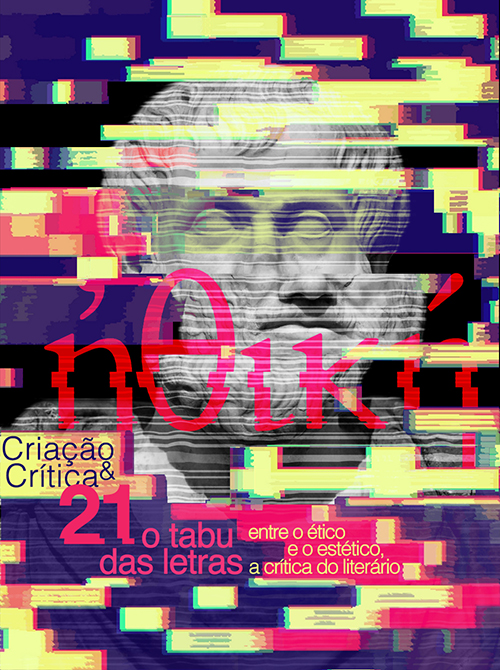ETHICS AND AESTHETICS IN “ESTÃO APENAS ENSAIANDO”, BY BERNARDO CARVALHO
DOI:
https://doi.org/10.11606/issn.1984-1124.v0i21p91-105Keywords:
Ethics; Aesthetics; Mimesis; Representation; ArtAbstract
In certain circumstances, seeing fictional writing as another dimension of reality seems to be equivalent to supposing that the wonder of a magic trick did not lie in the technical ingeniousness by which our senses are deceived, but in the idea that, for an instant, the laws of Physics were really suspended and a person levitated, or two bodies occupied the same space simultaneously. In the light of Ortega y Gasset’s considerations about the autonomy of the artistic object in relation to the reality the general public cannot do without when dealing with art, the short story “Estão apenas ensaiando”, by Bernardo Carvalho, is abundant with reading possibilities that highlight a clash between ethics and aesthetics, due to both its content and its expression. Therefore, in this analysis of Carvalho’s short story, we apply Gasset’s allegory and Adorno’s and Brecht’s ethical and narrative reflections in order to show how the chronological order between a catastrophic event and an artistic object that bears resemblance to it are little important in the interdiction of the aesthetic discourse.
Downloads
References
ADORNO, Theodor W.; DE ALMEIDA, Jorge Miranda. Indústria cultural e sociedade. São Paulo: Paz e Terra, 2002.
BARROS, Manoel de, O livro das ignorãças, 12. ed., Rio de Janeiro, Record, 2006.
BRAITH, Beth. A personagem. 3ª. ed. São Paulo: Ática, 1987.
COMPAGNON, Antoine. O demônio da teoria. Belo Horizonte: UFMG, 2001.
HJELMSLEV, Louis. Prolegômenos a uma teoria da linguagem. São Paulo: Perspectiva, 2006.
ISER, Wolfgang. Os atos de fingir ou o que é fictício no texto ficcional. Teoria da literatura em suas fontes, v. 2, p. 955-987, 2002.
MOISÉS, Massaud. Dicionário de termos literários. Editora Cultrix, 2013.
MORICONI, Italo. Os cem melhores contos brasileiros do século. Objetiva, 2000.
NIETZSCHE, Friedrich. Humano, demasiado Humano: um livro para espíritos livres. Trad. Paulo César de Souza. São Paulo: Companhia das Letras, 2000.
ORTEGA Y GASSET, José. A desumanização da arte. Trad. Ricardo Araújo, v. 5, 2001.
PERNIOLA, Mario. Pensando o ritual: sexualidade, morte, mundo. Trad. Maria do Rosário Toschi. São Paulo: Studio Nobel, 2000.
PIGLIA, Ricardo. Notas de um diário. Folha de São Paulo, trad. Paulo Werneck. São Paulo, jan. 2011. Disponível em: <http://www1.folha.uol.com.br/fsp/ilustrissima/il0901201107.htm>. Acesso em: 12 mar. 2017.
PLATÃO. A república. In: A República. 2000.
REYNOLDS, Simon. Lawrence circles Palahniuk's 'Survivor'. Digital Spy Magazine. London, ago. 2008. Disponível em: <http://www.digitalspy.com/movies/news/a123069/lawrence-circles-palahniuks-survivor/>. Acesso em: 17 abr. 2017.
RICHARDSON, Anna. The ethical limitations of Holocaust literary representation. ESharp, v. 5, 2005.
WOOD, James. Como funciona a ficção. Trad. Denise Bottman. São Paulo: Cosac Naify, 2011.
Downloads
Published
Issue
Section
License
Authors who publish with this journal agree to the following terms:
- Authors retain copyright and grant the journal right of first publication with the work simultaneously licensed under a Creative Commons Attribution License that allows others to share the work with an acknowledgment of the work's authorship and initial publication in this journal.
- Authors can enter into separate, additional contractual arrangements for the non-exclusive distribution of the journal's published version of the work (e.g., post it to an institutional repository or publish it in a book), with an acknowledgment of its initial publication in this journal.
- Authors are permitted and encouraged to post their work online (e.g., in institutional repositories or on their website) before and during the submission process, as it can lead to productive exchanges, as well as earlier and greater citation of published work (See The Effect of Open Access).



